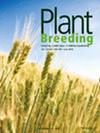Assessment of genotypic variability and genome‐wide association analysis of cooking time and canning quality traits in common bean (Phaseolus vulgaris L.)
IF 1.8
4区 农林科学
Q2 AGRONOMY
引用次数: 0
Abstract
Developing improved common bean varieties with short cooking time (CT) and good canning quality traits (CQTs) is very key for accelerating bean consumption among the urban and middle‐class population. The objective of this study was to assess the genotypic variability and identify single nucleotide polymorphism (SNP) markers associated with CT and CQTs in common bean. A total of 250 common bean accessions were evaluated under field conditions for two seasons using alpha lattice design with two replications. Three months post‐harvest, the dry bean grains were evaluated for CT and CQTs. Significant variation was observed among the 250 common bean accessions tested for both traits. CT ranged from 51 to 215 min, with 11 genotypes cooking in less than 60 min. The percentage total CQTs' score ranged from 41% to 84% with 31 genotypes scoring 76% and above. Forty‐seven significant GWAS signals were detected for CT on chromosomes Pv01, Pv04, Pv05 and Pv11 and CQTs on Pv01, Pv02, Pv03, Pv04, Pv05, Pv06, Pv07, Pv08, Pv10 and Pv11, respectively. Positional candidate genes including Phvul.005G161200 on chromosome Pv05, Phvul.007G2803001 and Phvul.007G280700 on chromosome Pv07 were associated with seed coat colour retention of the canned beans. Besides their usefulness in breeding research, the identified bean genotypes with shorter CT and good CQTs could enhance bean consumption and processing industries.蚕豆(Phaseolus vulgaris L.)蒸煮时间和罐头质量性状的基因型变异性评估和全基因组关联分析
开发烹饪时间(CT)短、罐头质量性状(CQTs)好的改良蚕豆品种是加快城市和中产阶级消费蚕豆的关键。本研究的目的是评估蚕豆的基因型变异性,并鉴定与蒸煮时间和 CQTs 相关的单核苷酸多态性(SNP)标记。在田间条件下,采用两次重复的阿尔法网格设计,对 250 个蚕豆品种进行了两季评估。收获后三个月,对干豆粒进行 CT 和 CQTs 评估。在接受测试的 250 个普通菜豆品种中,这两个性状都存在显著差异。蒸煮时间从 51 分钟到 215 分钟不等,其中有 11 个基因型的蒸煮时间少于 60 分钟。CQTs 总分的百分比从 41% 到 84% 不等,其中有 31 个基因型的得分在 76% 及以上。研究发现,Pv01、Pv04、Pv05 和 Pv11 染色体上的 CT 以及 Pv01、Pv02、Pv03、Pv04、Pv05、Pv06、Pv07、Pv08、Pv10 和 Pv11 染色体上的 CQTs 分别存在 47 个显著的 GWAS 信号。Pv05染色体上的Phvul.005G161200、Pv07染色体上的Phvul.007G2803001和Phvul.007G280700等位置候选基因与罐头豆种皮颜色保持率有关。除了对育种研究有用外,所鉴定的具有较短CT和良好CQT的豆类基因型还能促进豆类消费和加工业的发展。
本文章由计算机程序翻译,如有差异,请以英文原文为准。
求助全文
约1分钟内获得全文
求助全文
来源期刊

Plant Breeding
农林科学-农艺学
CiteScore
4.40
自引率
5.00%
发文量
74
审稿时长
3.0 months
期刊介绍:
PLANT BREEDING publishes full-length original manuscripts and review articles on all aspects of plant improvement, breeding methodologies, and genetics to include qualitative and quantitative inheritance and genomics of major crop species. PLANT BREEDING provides readers with cutting-edge information on use of molecular techniques and genomics as they relate to improving gain from selection. Since its subject matter embraces all aspects of crop improvement, its content is sought after by both industry and academia. Fields of interest: Genetics of cultivated plants as well as research in practical plant breeding.
 求助内容:
求助内容: 应助结果提醒方式:
应助结果提醒方式:


